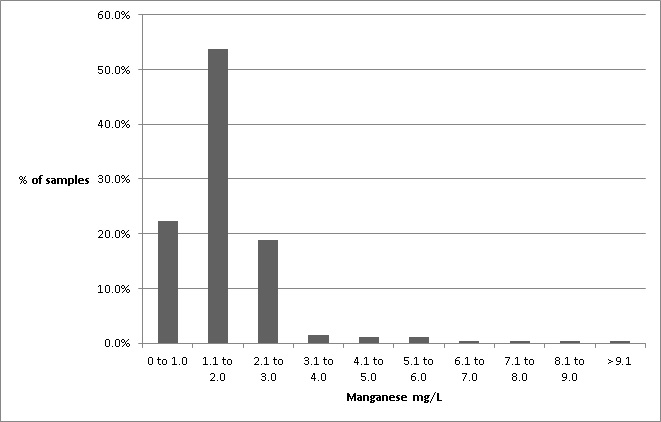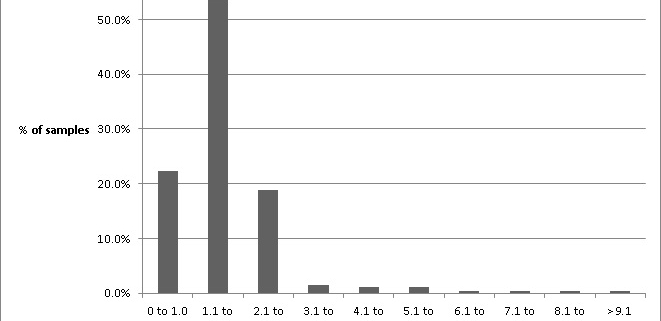Over 23% of wines tested for export to China exceed the manganese limit!
Introduction
Over 23% of the hundreds of wines we have tested for manganese recently are over the new limit imposed by China. This testing was recommended by Wine Australia in late February, for any wines exported to China because some wines have been over this limit and have been destroyed in China or returned to Australia.
Chinese limit on manganese
Wine Australia announced in late February 2014 that a number of wines sent to China had been rejected due to unacceptable levels of manganese. China has set a limit of 2 mg/L (ppm) of manganese (Mn) in imported wine. This is causing major problems for exporters, as manganese can be present naturally in Australian wines at levels above this limit.
The following is from the Wine Australia media release:
“Wine Australia recommends that before exporting wine to China it should be analysed for manganese content. We do this reluctantly, since we believe the limit of 2 mg/l imposed by Chinese authorities is not absolute. Chinese law controls the amount of manganese that can be added to wine, and Australians do not add manganese to their wine, neither do winemakers in other traditional wine producing countries.
“…Manganese is present naturally in wine. A wine may exceed this arbitrary limit of 2 mg/l despite manganese never having been added to the wine. Nevertheless, in the past 12 months we have reports of 14 Australian wines having been challenged after being analysed for manganese on arrival in China. We understand some of these wines may have been destroyed and some returned to Australia. Wine Australia is not aware of any country other than China that imposes such a limit on manganese content. “Unfortunately if you have a wine that exceeds this limit the safest course of action is not to send the wine to China.”
Why the limit of 2ppm for manganese has been set is not at all clear, however one report (1) from 2012 stated that other drinks in China had very high levels of manganese: “a famous dining brand was found to be selling products that contained manganese in excess of the GB (national standard) limits. Product recalls and safety scares have brought the use of chemicals in consumer products to prominence for China’s shoppers. At the same time, high profile incidents such as those listed above mean that the Chinese government and quality watchdog are taking a keen interest in the market and increasing supervisory activity.”
According to the Wine Australia Export Market Guide, the Chinese Health regulations allow potassium permanganate (KMnO4) to be used in alcoholic drinks up to 500 ppm (stated as 0.5g/kg), but then have a limit of 2 ppm as manganese in the finished product. This doesn’t appear to make any sense – you can use up to 500ppm but the residue limit is 2ppm! This additive (potassium permanganate) is not allowed in Australia for use in winemaking. The interest by the Chinese authorities in manganese may be more to check on the misuse of potassium permanganate than concerns about naturally occurring manganese.
Although this issue seems to be a shock to many exporters, to us it was no surprise as we had been performing manganese analyses for China exports for some of our clients for some time.
Wines tested
Since the Wine Australia announcement and by the time this article was written, hundreds of wines have been analysed for manganese content at Vintessential Laboratories.
Figure 1: Manganese content versus % of wines tested

The manganese content of wines tested by our laboratories since the Wine Australia announcement (up to the date of the submission of this article) is represented in Figure 1. It can be seen that although most wines are below the limit of 2 mg/L, there are a large number of wines that are above, with some well above this limit. In total there were 23% with a manganese concentration greater than 2.0 mg/L. If these wines had been sent to China they may have been rejected.
The highest concentration was for a red wine that had a concentration of 9.2 mg/L and the highest for a white was 2.8 mg/L. These results agree well with a study on manganese levels in French wines. The study performed in France in 2000 (2) into the levels of manganese in 80 samples of wine from various regions found that “The Mn concentrations ranged from 0.435 to 7.836 mg/L in red wine, from 0.674 to 2.203 mg/L in white wine, from 0.844 to 1.805 mg/L in rosé wine and from 0.358 to 0.733 mg/L in Champagne”.
Where does the manganese come from?
Manganese exists in trace amounts in soil and is taken up into grapes and therefore into wine. The level in soil naturally varies between soil type and region. Petiole tests that contain manganese data (such as the petiole testing bundles offered by Vintessential Laboratories) should give growers and winemakers some idea of the level of manganese drawn from the soil by the grapevines.
From the French study, and from our own findings, it would appear that red wine is the most likely to have manganese levels above the 2ppm limit that China has imposed. The reason for this is not clear, although one hypothesis is that manganese is held in the grape skins and that fermentation on skins releases more manganese into the wine.
Other sources of manganese could be from some popular vineyard sprays and also from the stainless steel used in wineries (3). This was highlighted some years ago and acid washing of stainless steel tanks was recommended to remove manganese sulfide deposits from such tanks (4).
Conclusion
Some Australian wine producers are at risk of having their wines returned or destroyed in China due to levels of manganese higher than the limits imposed by the Chinese authorities. Our testing over the past month has shown that over 23% of wines, predominantly red wines, are over this limit. It is not clear at this stage why some wines have higher manganese contents than others and whether this is purely a soil effect or other factors are at play.
2. Manganese Determination in Grapes and Wines From Different Regions of France,
C. Cabrera-Vique, P. L. Teissedre, M. T. Cabanis and J. C. Cabanis, Am. J. Enol. Vitic 2000 vol. 51 no. 2 pp103-107
3 Personal communication, Tony Comino, Kominos Wines, QLD
4. Making Good Wine, Rankine. B; Macmillan, Australia
Copyright© 2014 Vintessential Laboratories. No part of this publication may be reproduced in any form or by any means without the permission in writing from the copyright owner.



